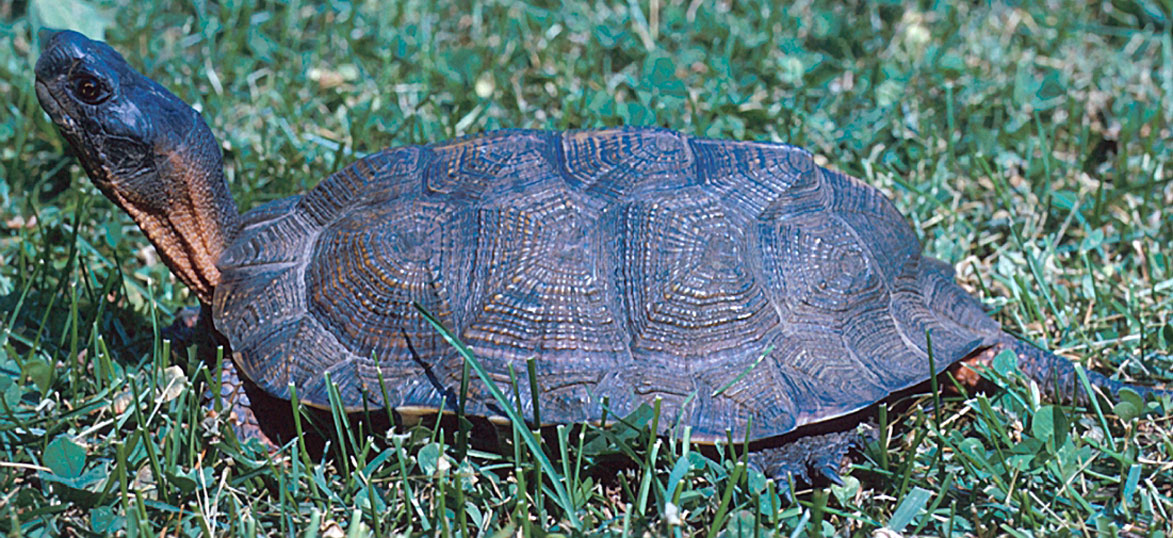
The wood turtle (Clemmys insculpta) is a moderately sized turtle with reddish-orange skin on portions of its neck and legs and a roughly textured, or sculpted shell. The adult's shell is about seven to eight inches long.
Turtles are an ancient group of animals, originating many millions of years ago. Wood turtles have likely been in Vermont for the past 10,000 years, following the retreat of the last glacier.
Habitat
It spends the winter on stream bottoms and most breeding occurs in streams. Although it regularly returns to streams throughout year, it may travel up to 1,000 feet from the stream while foraging for food in hardwood forests or meadows.
Reproduction
Adult wood turtles may live 60 years, but egg and hatchling survival is extremely low. Survival of adult wood turtles is key to maintaining this species. Mature turtles are important because they manage to produce the few offspring that will carry the population into the future.
Turtle Time Table
Early April - First emergence from water to stream bank. Initially, turtles stay near stream, and then gradually move farther away.
Early June - Initial movements to summer foraging areas which may be 1,000 feet from stream. These areas consist of meadows, wetlands and woods.
Mid June - Females with eggs move to nesting area. Some females will travel over one mile to nest. Return to foraging area within a few weeks.
June through mid-September - Turtles spend up to a month at a time foraging well away from stream, but return to the stream for short periods.
Late August through mid-November - Breeding occurs in the stream, and also occurs to a lesser extent in the spring months.
November through April - Turtles stay underwater at wintering sites in streams where they absorb oxygen through their skin. Some movement may occur during this time, but the turtles are generally confined to protected pools.
Diet
Wood turtles are omnivorous and eat insect larvae, fish, invertebrates, crayfish, and plants. They are skilled earthworm hunters, and they stamp the group with their front feet to bring earthworms to the surface so they can quickly grab and eat them.
Management
Wood turtles benefit from Fish & Wildlife Department habitat conservation efforts.
In spite of their long history of success, wood turtles have not fared well recently in the face of human development and use of the landscape. The wood turtle is a species of conservation concern in the northeastern states, including Vermont, due to its region-wide decline.
Human activities are the main cause of the turtles' decline. While it is rare that any person intentionally harms a wood turtle, the cumulative effect of our activities does have a negative impact. Although it is illegal to collect wood turtles in Vermont, people do remove them from the wild. Collection results in population decline and loss. A Connecticut wood turtle population was studied before and after a water supply area was opened to limited permit hiking. Wood turtle collection was the likely cause of this population disappearing after only ten years.
We also harm turtles by transforming their habitat into housing or commercial building lots, clearing away inadvertently hitting them with stream-bank vegetation, and mowing machines or cars.
What you can do
- Locate roads more than 1,000 feet from large streams and rivers.
- Locate housing and commercial development away from streams, rivers, and wetlands.
- Maintain natural vegetation along waterways.
- Route recreation paths away from streams, never along the channel.
- Teach children to respect wildlife. Leave wildlife in the wild.
- Encourage friends and neighbors to protect stream corridors.
- Promote town plans and ordinances that protect naturally vegetated stream corridors and discourage stream alterations.
- If possible, avoid mowing meadows until late September.
- If mowing May-September set mowing bar to 5 inches.
- Learn more about the natural world.
- Report collection of turtles to your local game warden.
- Report unauthorized stream alterations to the Agency of Natural Resources.
- Contribute to the Nongame Wildlife Fund on your Vermont income tax form.
- Display a Vermont Conservation Plate on your car - and watch out for turtles crossing the road!
